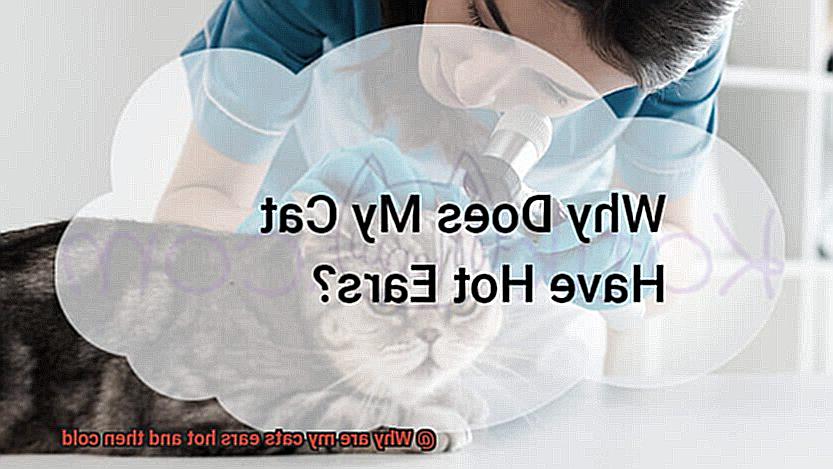As a cat parent, have you ever been perplexed by the constantly changing temperature of your feline friend’s ears? One moment they’re hot to the touch, and the next, they’re cold as ice. Don’t worry; you’re not alone in this confusion. Many cat owners struggle to comprehend this peculiar phenomenon.
Cats are unique creatures with an anatomy that allows them to regulate their internal temperature efficiently. Their ears serve as natural heat regulators, providing valuable insights into their overall well-being. The sudden shifts from hot to cold can be puzzling, but there’s a reason behind it.
Interestingly, a cat’s ears act like microclimates that help regulate their body temperature. This is because they have an abundant supply of tiny blood vessels that control the flow of heat in and out of their bodies. Sometimes, their ears will feel warm, indicating an elevated body temperature, while at other times, they may feel chilly, signaling a drop in temperature.
In this blog post, we’ll explore the reasons why your cat’s ears may feel hot or cold and what actions you can take. By understanding these subtle changes in your kitty’s body temperature, you could detect underlying health issues early on. So keep reading to learn more.

Reasons for Hot and Cold Ears in Cats
One such behavior is the fluctuation in temperature of their ears, which can go from hot to cold and vice versa within a matter of minutes. This phenomenon is not uncommon in cats, and there can be several reasons behind it.
Blood Circulation
Cats’ ears have a rich blood supply that helps regulate blood flow throughout their bodies. When a cat is excited or engaged in physical activity, its heart rate increases, leading to increased blood flow to the ears. This increased blood flow can cause the ears to feel warm or even hot. Conversely, when a cat is resting or sleeping, its heart rate slows down, reducing blood flow to the ears, causing them to feel cooler.
Environmental Factors
Cats’ ear temperature can also vary due to environmental factors such as weather changes and stress levels. For instance, during winters or on cold days, cats’ ears may feel colder due to the decrease in ambient temperature. Similarly, when a cat is under stress or anxious, it can cause blood vessels in the ear to constrict, making them feel cooler.
Medical Conditions
In addition to environmental factors and natural body regulation, hot and cold ears in cats could also be due to underlying medical conditions such as ear infections or injuries. Inflammation or swelling in the affected area can lead to increased blood flow to the ears, causing them to feel warm or hot. Likewise, if a cat is experiencing a fever or an allergic reaction, it may also result in hot and inflamed ears.

Thermoregulation Process
In fact, they play an essential role in regulating your cat’s body temperature through the process of thermoregulation. Let’s delve into this fascinating process and understand why your cat’s ears are so crucial in maintaining their optimal body temperature.
Thermoregulation is a vital bodily function that helps your cat maintain a normal range of body temperature. This is particularly important for cats, as they are highly susceptible to temperature extremes due to their unique physiology. A cat’s body produces heat through metabolism and dissipates it through various mechanisms such as sweating, panting, and vasodilation (widening of blood vessels).
A cat’s ears are highly vascularized, meaning they contain a vast network of blood vessels. Additionally, they have a large surface area relative to the size of their body. When your cat’s body temperature rises due to external factors such as physical activity or hot weather, the blood vessels in their ears dilate. This allows increased blood flow, which helps to dissipate excess heat from the body and cool it down.
On the other hand, when your cat’s body temperature drops due to factors such as cold weather or exposure to drafts, the blood vessels in their ears constrict. This reduces blood flow to the extremities and conserves heat, preventing heat loss from the body.
While changes in ear temperature may occur due to external factors such as sun exposure or cold weather, consistent hot or cold ear temperatures without any apparent cause may indicate an underlying issue with your cat’s health. For example, an ear infection or injury can cause abnormal ear temperature by dilating or constricting the blood vessels in the ear. If you notice any such changes, it is essential to seek veterinary attention promptly.

Stress or Anxiety
These emotions can cause fluctuating ear temperatures in cats, which is a common physiological response to stress and anxiety. When cats are feeling stressed or anxious, their bodies release hormones that cause their ears to become hot and then cold. This happens because the blood vessels in their ears dilate in response to the hormones, leading to an increase in blood flow and heat. When the stress or anxiety subsides, the blood vessels constrict, causing cooler temperatures.
It’s important to recognize that not all cats will display signs of stress or anxiety in the same way. Some may become more vocal or clingy, while others may withdraw and hide. As a cat owner, it’s crucial to monitor your cat’s behavior and body language to identify when they may be experiencing stress or anxiety.

There are several things you can do to help your cat if you suspect they are stressed or anxious. Providing a safe and comfortable environment with plenty of hiding spots and perches can help your cat feel more secure. Regular playtime and exercise can also reduce stress levels. If your cat’s stress or anxiety is severe, medication may be necessary, so it’s essential to consult with your veterinarian.
Fluctuating ear temperature can also indicate underlying medical issues, such as infections or allergies. Therefore, it’s vital to schedule regular check-ups with your veterinarian to catch any potential health concerns early on.
Underlying Health Issues
If you’ve observed changes in your cat’s ear temperature, this could be indicative of an underlying health issue. Let’s explore the most common factors that can cause these changes.

Firstly, infections. Ear infections can be caused by various culprits such as bacteria, fungi or parasites, leading to redness, swelling and warmth in your cat’s ears. Your cat may try to alleviate any itching or pain by scratching their ears or shaking their head.
Secondly, allergies can also lead to changes in ear temperature. From environmental triggers to certain foods, your cat’s ears can become hot and inflamed, accompanied by symptoms such as sneezing and itching.
Last but not least, inflammation. This can be caused by ear mites or ear polyps that cause your cat’s ears to feel warm and inflamed.
So what should you do if you notice changes in your cat’s ear temperature? The first step is to take them to the vet for a thorough check-up. The vet will be able to diagnose any underlying health issues and recommend the appropriate treatment. Remember: taking care of your cat’s overall health is essential for ensuring they continue to live a happy and healthy life.
Signs of Abnormal Ear Temperature in Cats
It can be challenging to detect when something is wrong with our cats. One way to monitor your cat’s health is by checking their ear temperature. Let’s delve into the signs of abnormal ear temperature in cats, so you know what to look out for.
The normal range for a cat’s ear temperature is between 100.5 and 102.5 degrees Fahrenheit. If your cat’s ear temperature falls outside this range, it could indicate an underlying issue that needs attention.
One sign of abnormal ear temperature in cats is when their ears feel excessively hot or warm to the touch. This may indicate a fever or infection, as the body ramps up its temperature to fight off infections. Keep an eye on your cat’s behavior and other symptoms and contact your veterinarian immediately if necessary.
Conversely, if your cat’s ears feel unusually cold to the touch, this could indicate poor circulation or hypothermia. It would be best if you warmed them up gradually and seek veterinary attention promptly.
Other signs of abnormal ear temperature in cats include redness, swelling, discharge, inflammation, or sensitivity when touched. These symptoms may suggest an ear infection or injury that can be uncomfortable and painful for your cat. If you notice any of these signs, take your cat to the vet for a thorough examination.
How to Monitor Your Cat’s Ear Temperature
Cats are known for their keen sense of hearing, and monitoring their ear temperature can provide valuable insight into their overall health. Here are five detailed steps to follow when monitoring your cat’s ear temperature:
Know the Normal Range
To properly monitor your cat’s ear temperature, it’s crucial to know what the normal range is. The normal range for a cat’s ear temperature is between 100.4°F and 102.5°F (38°C to 39.2°C). It’s essential to establish the baseline temperature for your cat during times when they are healthy and active, so you can quickly identify any abnormal changes.
Use a Digital Thermometer
Using a digital thermometer specifically designed for pets is the safest way to measure your cat’s ear temperature accurately. These thermometers can be found at most pet stores or online retailers. Before taking your cat’s temperature, ensure that the thermometer is clean and lubricated with petroleum jelly or water-based lubricant.

Insert the Thermometer Gently
Taking your cat’s temperature might sound like a daunting task, but it doesn’t have to be. Gently lift your cat’s ear flap and insert the thermometer into the ear canal. Be sure not to force it in too far as this could cause injury to your feline friend. Hold the thermometer in place until it beeps or until the reading stabilizes.
Monitor Your Cat’s Behavior
It’s essential to keep in mind that your cat’s ear temperature may fluctuate throughout the day and in response to various stimuli such as exercise, stress, and environmental changes. Therefore, it is crucial to monitor your cat’s overall behavior and health in conjunction with their ear temperature readings.
Seek Veterinary Care if Necessary
If you notice any significant changes in your cat’s ear temperature or behavior, such as lethargy, loss of appetite, vomiting, or diarrhea, seek veterinary care immediately. These may be signs of an underlying health issue that requires prompt attention. Remember, early detection and treatment are key to ensuring your cat’s well-being.
Tips to Help Manage Cat’s Ear Temperature
Cats are known for their warm ears, but sudden changes in temperature can be a sign of underlying health issues. To help manage your cat’s ear temperature, there are a few tips you can follow.
Monitor Your Cat’s Behavior and Health
As a responsible pet owner, it is important to pay attention to your cat’s behavior and health. Cats’ ears can change temperature due to various reasons such as stress, activity levels, environmental changes, or an illness. Therefore, it is crucial to observe any changes in their behavior or health to determine the underlying cause of the fluctuating ear temperature.
If you notice that your cat’s ears are consistently hot or cold, consulting with your veterinarian is recommended to rule out any underlying health issues.
Provide a Comfortable Living Environment

Creating a comfortable and temperature-controlled environment for your cat is essential to managing their ear temperature. Ensure that their living space has proper ventilation and insulation and provide them with a cozy bed or blanket to snuggle up in.
During colder months, you could consider using a heated pad or blanket to keep your cat warm and comfortable.
Regularly Groom Your Cat’s Ears
Keeping your cat’s ears clean is crucial in managing their ear temperature. Dirty ears can trap heat and cause discomfort for your feline friend. So, it is important to clean their ears regularly with a damp cloth or cotton ball. However, avoid using any harsh chemicals or tools that could damage their delicate ear canal.

Regular grooming can also help prevent ear infections and other ear-related health issues.

Provide Plenty of Water and Hydration
Proper hydration is essential for regulating your cat’s body temperature and preventing overheating. Ensure that they have access to fresh water at all times and consider adding wet food or treats to their diet to increase their water intake.
Dehydration can lead to various health problems, so it is crucial to ensure that your cat is properly hydrated at all times.
Schedule Regular Check-Ups with Your Veterinarian
Regular check-ups with your veterinarian can help detect any potential health issues early on before they become more serious. Your vet can provide advice and guidance on how to manage your cat’s ear temperature and overall health.
Potential Complications of Uncontrolled Ear Temperature in Cats
While this is normal, uncontrolled ear temperature can lead to potential complications that can affect your cat’s overall health. It is essential to be aware of these risks and take action to prevent them.
One of the most common potential complications of uncontrolled ear temperature in cats is ear infections. If your cat’s ears are consistently too warm for an extended period, bacteria and yeast can thrive, leading to an infection. These infections can cause pain, inflammation, and discharge from the ear, and if left untreated, they can even lead to hearing loss.
Another potential complication is hyperthermia, which occurs when a cat’s body temperature rises above its normal range. Consistently warm ears can cause an increase in overall body temperature, leading to symptoms such as lethargy, panting, vomiting, and even seizures. It is crucial to monitor your cat’s body temperature regularly and seek veterinary attention if any symptoms occur.
In contrast, if your cat’s ears are consistently cold or cool to the touch, it may indicate poor circulation or hypothermia. This can happen if your cat is exposed to low temperatures or has an underlying medical condition affecting its circulation. Hypothermia can cause symptoms such as shivering, lethargy, and even unconsciousness. It is essential to keep your cat warm during cold weather and seek veterinary attention immediately if any symptoms occur.
To prevent potential complications from uncontrolled ear temperature in cats, it’s important to monitor your cat’s body temperature regularly. Proper ventilation and insulation in their living environment can also help regulate their temperature. Regular grooming of their ears can prevent infections, while ensuring they stay hydrated with fresh water and wet food or treats is also important. Additionally, scheduling regular check-ups with your veterinarian can help detect any potential health issues early on.
When to Seek Veterinary Care for Your Cat’s Ears
Therefore, it is essential to keep a close eye on them and know when to seek veterinary care. If you notice that your cat’s ears are hot and then cold, it may be an indication of an underlying problem.
Ear Infections
One of the most common reasons for hot and cold ears in cats is an ear infection. This painful condition can cause discomfort and even lead to hearing loss if left untreated. Symptoms of an ear infection include redness, swelling, discharge, or a foul odor from the ear. If you notice any of these symptoms in your cat, it’s best to schedule a visit with your veterinarian right away.
Allergic Reactions
Another reason your cat’s ears might feel hot and then cold is due to an allergic reaction. Cats can be allergic to various factors such as food, environmental irritants like pollen or dust, or even certain types of litter. Allergic reactions can cause inflammation in the ears, leading to discomfort and changes in temperature. If you suspect that your cat has an allergic reaction, consult with your veterinarian for appropriate treatment.
Underlying Health Conditions
Hot and cold ears in cats can also be a sign of underlying health conditions such as hyperthyroidism or anemia. These serious conditions require prompt medical attention from a veterinarian. Therefore, if you notice any unusual changes in your cat’s behavior or physical appearance, including their ears feeling hot and then cold, it is best to consult with your veterinarian.
When to Seek Veterinary Care
It is essential to seek veterinary care for your cat’s ears as soon as possible to prevent complications. Regular check-ups with your veterinarian can help identify any potential issues early on. Additionally, proper living conditions and grooming can go a long way in preventing ear infections and other related problems.

Treatment Options for Abnormal Ear Temperatures in Cats

One common sign that something might be amiss is an abnormal ear temperature. While it’s possible that a cat’s ears may naturally vary in temperature, it could also be a warning sign of an underlying health condition.
If you’re concerned about your cat’s ear temperature, the first step is to take them to the vet for diagnosis. Depending on the root cause of the issue, there are several treatment options available.
For instance, hot ears might indicate an ear infection, and your vet may prescribe antibiotics or other medications to address the problem. Be sure to follow their instructions closely and complete the entire course of treatment, even if your cat appears to be feeling better.
In contrast, cold ears could be due to poor circulation or hypothermia. If your cat’s ears feel chilly and they seem lethargic or are shivering, it’s critical to warm them up slowly and seek veterinary care immediately. Your vet may suggest using warm blankets or a heating pad to gradually raise their body temperature.
Along with medical treatment, there are also some home remedies that can help improve blood flow to your cat’s ears and speed up healing. These include gently massaging the ears, applying warm compresses, and using herbal remedies such as chamomile or tea tree oil.
Overall, seeking veterinary care and following their recommendations for treatment is crucial when dealing with abnormal ear temperatures in cats. With proper care and attention, most cats will recover from underlying health issues and return to their happy and healthy selves.
Prevention Strategies For Hot and Cold Ears In Cats
To achieve this, it’s essential to take preventive measures against hot and cold ears. Here are some strategies that you can implement to help keep your cat’s ears in the pink of health.
Firstly, monitoring your cat’s body temperature is crucial. Regularly checking their ears, nose, and paw pads can give you an idea of their overall health. If their ears consistently feel hot or cold, it could be a sign of an underlying issue that needs to be addressed.
Proper hydration and nutrition are also key to preventing hot and cold ears. Dehydration can lead to a rise in body temperature, which can cause discomfort in your cat’s ears. Ensure that they have access to fresh water at all times and feed them high-quality food to keep them healthy and well-nourished.
To prevent ear mites and infections, keeping your cat’s ears clean and dry is critical. Ear mites are a common cause of ear irritation in cats, leading to hot and inflamed ears. Regular grooming, such as brushing their coat, can help remove any debris that may be causing irritation around their ears. This will promote good air circulation around the ears, preventing overheating or coldness.
Moreover, keeping your cat indoors can help prevent fluctuation in body temperature due to exposure to extreme weather conditions. Indoor cats are less likely to experience hot or cold drafts that can cause discomfort. They are also less likely to come into contact with other animals that may have infections or parasites.
nJzXge4MVlU” >
Conclusion
It’s important to pay attention to your cat’s ears as they can be a good indicator of their overall health.
If you notice that your cat’s ears are hot and then cold, it could be due to a variety of reasons such as changes in temperature or blood flow. However, if this is accompanied by other symptoms like lethargy or loss of appetite, it may be a sign of an underlying medical condition.
It’s always best to consult with your veterinarian if you have any concerns about your cat’s health.







